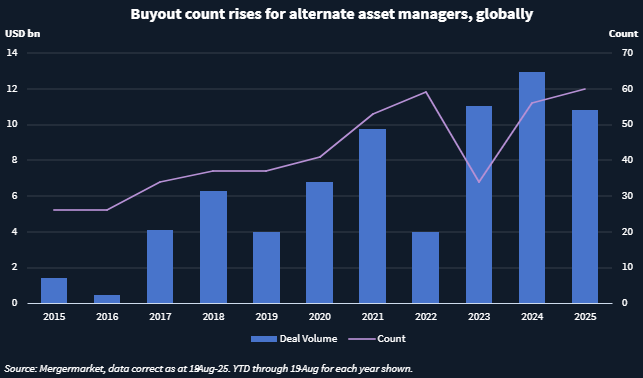Blackstone sees robust GP stakes pipeline amid PE, infra opportunities
- Blackstone’s GP stakes deal pipeline has grown 65% year-over-year
- Bullish on private equity and infrastructure, more cautious on private credit
- Currently raising third GP stakes fund, with reported target of USD 5.6bn
Blackstone is seeing a surge in its pipeline of general partners (GP) stakes opportunities, as a new generation of alternative asset managers seeks liquidity solutions.
“More lower middle and middle market firms are seeking strategic support, and thinking about how a strategic partner can help them institutionalize faster to be better adapted to handling new complexities facing the industry,” Joshua Blaine, a senior managing director and head of GP stakes, told Mergermarket.
Blackstone reported USD 11.6bn in assets under management (AUM) for its GP stakes strategy as of 2Q25, up from USD 9.8bn last year. The firm has seen a 65% year-on-year increase in its GP stakes deal pipeline, said Blaine.
This comes as many private markets managers have reached a stage in their development where they have established track records but are pondering next steps on how best to compete in an increasingly crowded marketplace.
Among the opportunities, Blackstone has a continued preference for private equity GPs. This is partly because they represent a large market with high margins, while many GPs will also venture into real assets or credit, said Blaine.
Infrastructure is also an attractive GP stakes opportunity, said Blaine, noting that, while there is a wave of consolidation in the space, there is a layer of specialist middle market players who are looking to scale rather than be acquired.
Blackstone currently has no solely private credit-focused GPs in its portfolio, despite the asset class’s rapid growth. Its exposure comes from GPs with credit strategies rather than dedicated firms. Much of the growth in private credit has been concentrated among the largest players, including Blackstone, leaving many smaller players struggling to keep up.
“While we’re spending time there and we really like the asset class, the bar is higher,” Blaine said. “For us, it’s a smaller number of candidates where we think they will truly end up being independent winners in the space as opposed to remaining sub scale or just being consolidated.”
Across asset classes, many GPs are turning to M&A as they face a cascade of challenges, including heightened competition for fundraising dollars, technological change, and a need to expand product offerings. This has propelled a 70% increase in asset management M&A volume last year compared to 2023. Year-to-date, deal count is on pace to eclipse last year’s total, with 60 transactions, compared to 56 for the same period in 2024.

Rather than being subsumed into a larger manager, many firms prefer to preserve their independence. Selling a minority stake to a GP stakes investor provides both liquidity as well as the ability to tap its resources and expertise.
In these scenarios, Blaine sees a competitive advantage for Blackstone, given the depth of its experience over four decades. “We’ve learned the lessons and -along with our strategic capabilities- those lessons are what we want to bring to bear in partnership with our GPs,” he said.
Selectivity
GP stakes strategies have been around for more than two decades. Blackstone raised its first fund dedicated to the strategy in 2014.
Since then, the firm has invested in a swathe of GPs, including Leonard Green and more recently, American Industrial Partners. Blackstone is currently raising its third GP stakes fund with a USD 5.6bn target, according to news reports.
Last year, it rolled its GP stakes business into Blackstone Strategic Partners, which also houses its secondaries arm. The approach across both strategies is similar, particularly the diligence process when selecting GPs.
One of the advantages of having both businesses on the same platform is that it provides a wealth of data for predictive analysis, which Blaine noted is a critical function for the GP stakes business in a sluggish exit environment. “We pride ourselves on the capability to underwrite the unrealized portfolio companies of GPs by doing our own proprietary, predictive forecasting of what we think track records will look like in the future,” he said. “That’s where the same technology that’s utilized in secondaries can be applied in GP stakes.”
With tens of thousands of GPs out there, Blackstone is disciplined when it comes to deal selection, investing in up to four transactions per year, according to Blaine.
A demonstrable track record that is replicable, defensible and differentiated over time is “table stakes” for its investment targets. Managers who can show this are those that Blackstone feels best positioned to support. “We’re not going to tell them how to invest,” added Blaine. “They’ve made great exits, proving their strategy works and crystallized great outcomes, so they’re really doing what they told investors they said they would.”
As a minority investor, Blackstone does not play an active role in investment decisions at its partner GPs. However, it provides support in areas such as product expansion and strategic development. To date, Blaine said Blackstone’s 16 GP partners have raised about USD 38bn across 21 new strategies since partnering with Blackstone.
Meanwhile, in a challenging environment for distributions, GP staking strategies have remained an attractive prospect for limited partners (LPs) – institutional investors in private equity funds run by GPs. A recent survey by McKinsey & Co. found that 43% of LP respondents had allocated to these strategies.
“I think in an environment like we’ve seen in the last three years, the stability of long-recurring contracted management fees allows us to produce a consistent yield to our investors even when exit activity and M&A is slower,” said Blaine.












